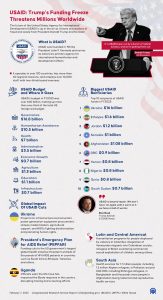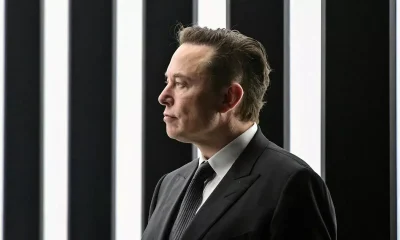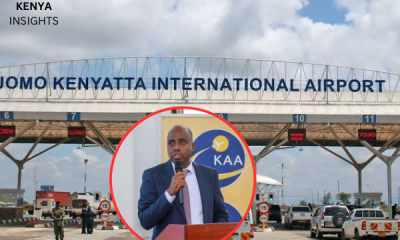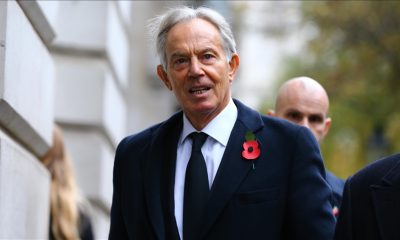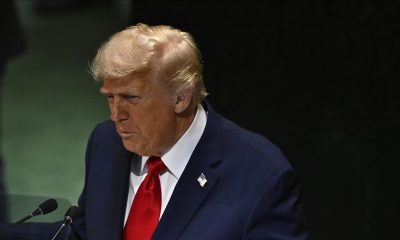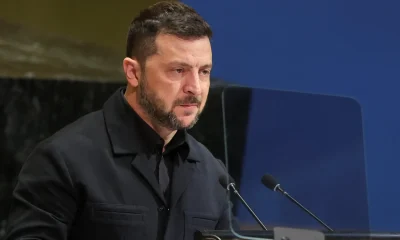World
FACTBOX – USAID Cuts: Why Trump’s Funding Freeze Threatens Millions Worldwide
PEPFAR is the US government’s largest global health initiative aimed at combating HIV/AIDS. With over $110 billion invested, it is the biggest single-disease effort by any country. As of 2023, it has saved over 25 million lives, mainly in sub-Saharan Africa, according to USAID.
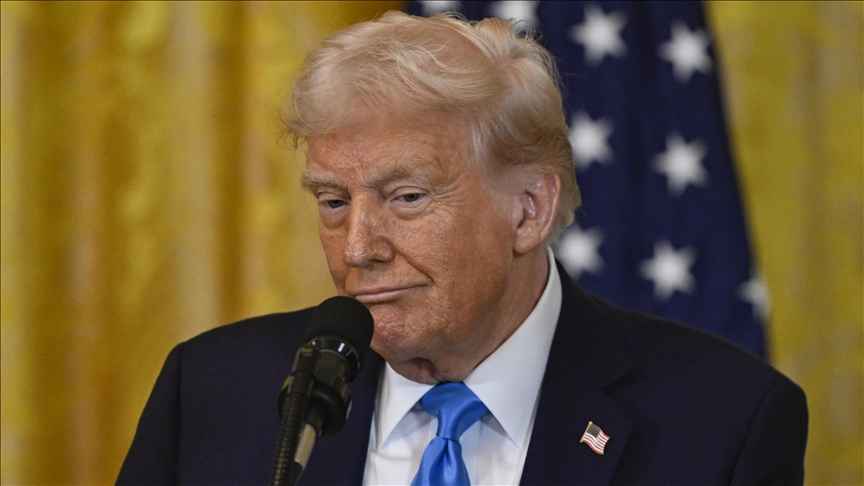
- Funding freeze raises concerns about future of global programs, including PEPFAR that allegedly saved over 25M lives
The US Agency for International Development (USAID) is under political scrutiny as the Trump administration considers merging it with the State Department in an effort to streamline federal bureaucracy.
As the world’s largest donor of humanitarian aid, the United States allocated $13.9 billion in 2024, accounting for 42% of all UN-tracked assistance. However, on Jan. 20, the White House announced a freeze on USAID’s budget, citing concerns over misaligned priorities.
President Donald Trump suspended development assistance for 90 days to evaluate its alignment with his “America First” policy, a move that has sparked concern among global aid organizations.
A White House statement asserted that USAID’s initiatives “do not align with American interests” and, in some cases, “destabilize world peace.”
On Feb. 4, USAID announced that all direct-hire personnel, except those in mission-critical roles, would be placed on leave by Feb. 7. Additionally, overseas staff are set to be repatriated within 30 days.
“It’s been run by a bunch of radical lunatics, and we’re getting them out,” Trump told reporters.
Meanwhile, on Feb. 3, Elon Musk, head of the Department of Government Efficiency, or DOGE, confirmed his involvement in the decision, stating: “I reviewed it thoroughly with (the president), and he concurred that we should shut it down.”
What is USAID?
Founded in 1961 by President John F. Kennedy under the Foreign Assistance Act, USAID is the US government’s primary agency for international humanitarian and development efforts.
Its alleged aim is to reduce poverty, combat disease, provide humanitarian aid, and foster economic growth in developing nations, while advancing US foreign policy objectives.
Operating in over 130 countries, USAID runs more than 60 regional missions and employs over 10,000 staff, with two-thirds based overseas.
Most of its programs are executed through grants, cooperative agreements, and contracts with nonprofit organizations, universities, international groups, and foreign governments.
How much is USAID’s budget and where does it go?
In Fiscal Year 2023 (FY2023), the latest data existing, USAID-managed combined fund had a budget of over $40 billion, making up more than one-third of the total US foreign aid budget, according to a Congressional Research Service Report updated this January.
USAID’s funding was primarily allocated across three key sectors: $16.8 billion to governance, $10.5 billion to humanitarian assistance, and $7.0 billion to health.
Other key areas included administrative costs ($3.5 billion), agriculture ($1.3 billion), education ($1.1 billion), infrastructure ($0.7 billion), and economic growth ($0.7 billion).
In FY2023, governance received the largest share, driven by substantial financial support for Ukraine, while humanitarian assistance surpassed the amount of health funding in FY2022.
Health, historically the largest sector, continued to receive significant funding, largely supported by initiatives like PEPFAR (President’s Emergency Plan for AIDS Relief) and COVID-19 relief efforts.
Who gets the most support from USAID?
According to the Congressional report, approximately 70 out of the 77 countries that the World Bank classifies as low and lower-middle-income nations received USAID assistance in 2023.
On a regional basis, around 40% of USAID-managed funds for 2023 were allocated to Europe and Eurasia ($17.2 billion), followed by Sub-Saharan Africa ($12.1 billion), Middle East and North Africa ($3.9 billion), South and Central Asia ($1.9 billion), and other regions ($8.4 billion), according to an analysis of data from USASpending.gov.
In FY2023, USAID-managed funds supported approximately 130 countries, with the top 10 recipients being Ukraine, Ethiopia, Jordan, the Democratic Republic of Congo, Somalia, Yemen, Afghanistan, Nigeria, South Sudan, and Syria, in descending order of funding.
Focusing solely on USAID funds for these countries, the disparity is stark, as Ukraine alone received $16 billion, the top beneficiary in FY2023, followed by Ethiopia with $1.6 billion and Jordan with $1.2 billion. Afghanistan received $1.08 billion, while Somalia was allocated $1 billion.
The Democratic Republic of Congo received $0.9 billion, followed by Yemen, Nigeria, and Syria, each receiving $0.8 billion. South Sudan received the lowest among the top recipients, with $0.7 billion.
What is the global impact of USAID freeze?
The freeze on USAID funding is significantly impacting critical humanitarian and health programs across the globe.
Ukraine’s military funding remains unaffected, but the funding freeze will impact infrastructure rebuilding, power generation, railway modernization (e.g., Mostyska–Lviv), border improvements with the EU, and agricultural support.
NGOs countering Russian disinformation and monitoring human rights will also be affected, according to a report by the Center for Eastern Studies.
Another major program disrupted by Trump’s orders is the President’s Emergency Plan for AIDS Relief (PEPFAR), including countries such as South Africa, where the government has warned that nearly 20% of its $2.3 billion annual HIV/AIDS program could be at risk.
PEPFAR is the US government’s largest global health initiative aimed at combating HIV/AIDS. With over $110 billion invested, it is the biggest single-disease effort by any country. As of 2023, it has saved over 25 million lives, mainly in sub-Saharan Africa, according to USAID.
The funding freeze also poses a serious threat to HIV services in Ethiopia, potentially affecting 503,000 patients across 1,400 facilities, with risks of treatment disruptions, according to UNAIDS. The possible termination of 5,000 health workers and 10,000 data clerks, along with supply chain delays, could undermine critical diagnostics and HIV progress.
A PEPFAR-funded program in Kenya has been suspended as well. Launched in 2022, the $32.5 million initiative aimed to provide HIV treatment, prevention, and support in Nairobi, Kajiado County, and beyond. The suspension has closed 150 clinics, affecting 72,000 HIV patients.
The USAID funding freeze under the Trump administration is exacerbating Uganda’s Ebola outbreak, delaying critical aid and disrupting response efforts. The suspension has led to understaffed contact tracing and inadequate screening of departing international travelers, as reported by CBS News.
The freeze on US foreign aid has also led to the suspension of many humanitarian programs in Latin America and Central America.
In Colombia, at least three humanitarian organizations have suspended support operations for more than 41,000 people displaced by recent guerrilla violence, according to a report by The Guardian. A program aimed at integrating hundreds of thousands of Venezuelan migrants into Colombian society by providing job opportunities has also been paralyzed.
In Brazil, two organizations assisting Venezuelan refugees have shut down their operations, and a program targeting the commercial sexual exploitation of children has been ordered to stop.
In South Asia, the Trump administration’s aid freeze will cut off health services for 1.7 million people in Pakistan, including 1.2 million Afghan refugees, due to the closure of 60 facilities, according to the UN.
In Bangladesh, around 600,000 people, including Rohingya refugees, risk losing maternal and reproductive health services, while UN officials have warned that Afghanistan could see “1,200 additional maternal deaths and 109,000 unintended pregnancies” from 2025 to 2028.
What are Trump’s concerns about USAID?
President Trump and his administration have voiced strong opinions against USAID, criticizing its foreign aid efforts for being “not aligned with American interests” and often “destabilizing world peace.”
A White House statement criticized several USAID-funded projects, deeming them controversial or wasteful.
These included $1.5 million for advancing “diversity, equity, and inclusion” in Serbia’s workplaces, $70,000 for a “DEI musical” in Ireland, and $2.5 million for electric vehicles in Vietnam.
Additionally, $47,000 was allocated to a “transgender opera” in Colombia, and $2 million was spent on sex changes and “LGBT activism” in Guatemala.
The statement also criticized $6 million for a tourism fund in Egypt, and claimed that USAID funds were used to support “al Qaeda-affiliated fighters in Syria.”
Further, the statement criticized a spending on “personalized” contraceptives and millions used for “irrigation canals, farming equipment, and fertilizer” in Afghanistan, which the statement suggested “supported the Taliban’s poppy cultivation and heroin production.”
The White House argued these examples were indicative of waste, fraud, and misuse of funds.
Echoing these criticisms, Elon Musk described USAID as “beyond repair,” adding: “We don’t have ‘an apple with a worm in it,’ we have a ball of worms.”
USAID’s funding of LGBTQ+ worldwide
USAID has allocated substantial funds to various LGBTQ+ advocacy organizations, sparking criticism from the Trump administration.
For example, Asociacion Lambda, based in Guatemala, has been allocated $1.9 million according to USASpending.gov.
The organization’s official website describes its work as “Since its inception, it has fought for the equality, dignity and participation of LGBTIQ+ people,”
In South Africa, OUT LGBT Well-Being is allocated $3.1 million. According to the organization’s official website, it works on promoting the well-being of the LGBTQ+o be able to secure “the empowerment, human rights and access to equitable services,”
Another group that received criticism is Grupa Izadji, a Serbian NGO, another organization which the Biden administration allocated $1.5 million to.
The organization states on their website thata “Our vision is a society in which LGBTI individuals have the opportunity to fully realize their potential,”
However, Trump’s foreign aid freeze has halted funding for the group, cutting off expected support through the end of FY 2025.
In India, USAID partnered with Johns Hopkins University to establish the country’s first transgender clinic, Mitr, providing health care services to the transgender community.
(Anadolu Agency)
Kenya Insights allows guest blogging, if you want to be published on Kenya’s most authoritative and accurate blog, have an expose, news TIPS, story angles, human interest stories, drop us an email on [email protected] or via Telegram
-

 Investigations2 weeks ago
Investigations2 weeks agoHow Land Grabbing Cartels Have Captured Ardhi House
-

 Business1 week ago
Business1 week agoPanic As Payless Africa Freezes With Billions of Customers Cash After Costly Jambopay Blunder
-

 News2 weeks ago
News2 weeks agoSCANDAL: Cocoa Luxury Resort Manager Returns to Post After Alleged Sh28 Million Bribe Clears Sexual Harassment and Racism Claims
-

 Investigations1 week ago
Investigations1 week agoHow SportPesa Outfoxed Paul Ndung’u Of His Stakes With A Wrong Address Letter
-

 Business2 weeks ago
Business2 weeks agoMwananchi Credit Faces Massive Lawsuits After Court Flags Predatory Lending That Left Customers’ Loans Ballooning
-
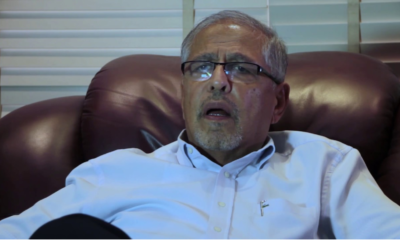
 News2 days ago
News2 days agoTemporary Reprieve As Mohamed Jaffer Wins Mombasa Land Compensation Despite Losing LPG Monopoly and Bitter Fallout With Johos
-

 News1 week ago
News1 week agoRentokil Boss Fraser Branch in Highway Smash as DUI and Racism Claims Surface
-
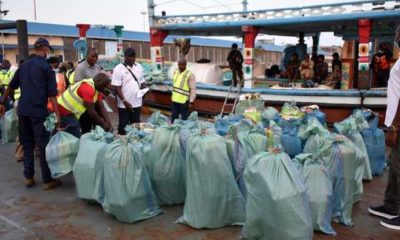
 Investigations2 weeks ago
Investigations2 weeks agoHow Arrest of a Soldier’s Spouse Dragged KDF Into Alleged Theft of Meth Haul in Mombasa

